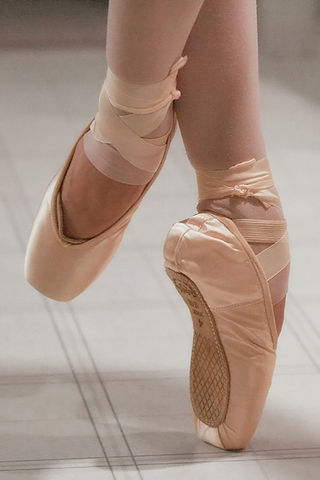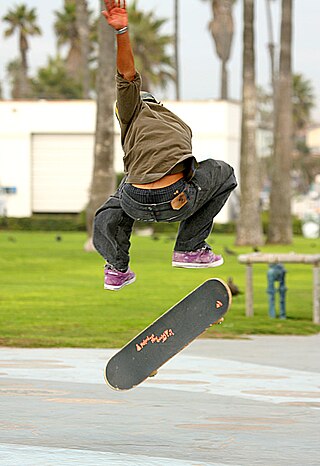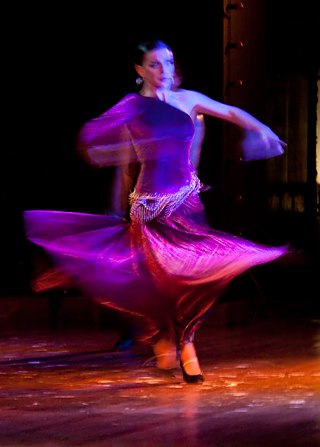Related Research Articles

A shoe is an item of footwear intended to protect and comfort the human foot. Though the human foot can adapt to varied terrains and climate conditions, it is vulnerable, and shoes provide protection. Form was originally tied to function but over time shoes also became fashion items. Some shoes are worn as safety equipment, such as steel-toe boots, which are required footwear at industrial worksites.

Snowboards are boards where the user places both feet, usually secured, to the same board. The board itself is wider than most skis, with the ability to glide on snow. Snowboards widths are between 6 and 12 inches or 15 to 30 centimeters. Snowboards are differentiated from monoskis by the stance of the user. In monoskiing, the user stands with feet inline with direction of travel, whereas in snowboarding, users stand with feet transverse to the longitude of the board. Users of such equipment may be referred to as snowboarders. Commercial snowboards generally require extra equipment such as bindings and special boots which help secure both feet of a snowboarder, who generally ride in an upright position. These types of boards are commonly used by people at ski hills, mountains, backcountry, or resorts for leisure, entertainment, and competitive purposes in the activity called snowboarding.

The kickflip is a skateboarding trick, in which the rider flips their skateboard 360° along the axis that extends from the nose to the tail of the deck. When the rider is regular footed the board spins counter-clockwise if viewed from the side.
Because ballet became formalized in France, a significant part of ballet terminology is in the French language.

A pointe shoe, also called a ballet shoe, is a type of shoe worn by ballet dancers when performing pointe work. Pointe shoes were conceived in response to the desire for dancers to appear weightless and sylph-like and have evolved to enable dancers to dance en pointe for extended periods of time. They are manufactured in a variety of colors, most commonly in shades of light pink.

A longboard is a type of skateboard typified by longer decks and wheelbases, larger-diameter and softer (lower-durometer) wheels, and often lower riding height compared to street skateboards, though there is wide variation in the geometry and construction of longboards. Among the earliest types of skateboards, longboards were inspired by surfing, with early longboards drawing from the design of surfboards, resembling and mimicking the motion of riding a surfboard, but adapted to riding on streets in a practice known as sidewalk surfing.

Longboarding is a variation of skateboarding typified by the use of longer boards (“decks”) with longer wheelbases and softer wheels. While longboards vary widely in shape and size, compared to street skateboards longboards are designed to be more stable at speed and to have more traction due to larger wheel sizes and softer wheel durometers. While standard street skateboards may typically be between 28 to 34 inches long, longboards can range anywhere from 32 to 50 inches in length. Ride characteristics of longboards generally differ from that of street skateboards due to the use of specialized longboard trucks that have different properties than those typically used with skateboards; while street skateboards use “traditional kingpin” (TKP) trucks that are optimized for tight turning radii, ollie and flip tricks, slides, grinds, and transition skating, longboards are typically paired with “reverse kingpin” (RKP) trucks that are designed for increased stability at higher speeds, more “surfy” carving characteristics, and/or greater ride comfort for commuting over longer distances.
A foilboard, also known as a hydrofoil board or foil surfboard, is a type of board used in water sports; it is distinct from surfboards in that it has a hydrofoil rather than fins mounted underneath. This hydrofoil design allows the surfboard and its rider to rise above the water’s surface, allowing for fast speeds and increased maneuverability in a wide range of surf conditions. Foilboards are becoming increasingly popular across many water sports, including surfing, kiteboarding, and wakeboarding. Foilboards have also been used in competitions, with riders reaching speeds of up to 30 km/h while performing acrobatic maneuvers such as flips, twists, and more.
A freestyle skateboarding trick is a trick performed with a skateboard while freestyle skateboarding. Some of these tricks are done in a stationary position, unlike many other skateboarding tricks. The keys to a good freestyle contest run are variety, difficulty, fluidity, and creativity. This is an incomplete list, which includes most notable tricks.

Tiptoe describes the human body posture and locomotion of removing the heel(s) of one or both feet from the ground. The term is mostly used colloquially when the weight is placed on the balls of the feet rather than literally on the tips of the toes; literal tip-toeing is difficult but possible, as in the pointe technique of ballet. In running, landing on the ball of the foot is known as forefoot strike.
The following is a glossary of figure skating terms, sorted alphabetically.

In ballet, turnout is rotation of the leg at the hips which causes the feet to turn outward, away from the front of the body. This rotation allows for greater extension of the leg, especially when raising it to the side and rear. Turnout is an essential part of classical ballet technique.

A caster board, vigorboard or waveboard is a two-wheeled, human-powered land vehicle. Other names are J-board and RipStik, both of which are derived from commercial brands.

A skateboard is a type of sports equipment used for skateboarding. It is usually made of a specially designed 7–8-ply maple plywood deck and has polyurethane wheels attached to the underside by a pair of skateboarding trucks.
In dance, a pivot turn is a general classification for dance turns in which the performer's body rotates about its vertical axis without traveling. The performer may be supported by one or both feet, which swivel in place during the pivot turn. In some dance genres, a pivot on both feet is called a twist turn. Pivot turns are commonly named as such in ballroom dancing, folk dancing and ethnic dances. In many other dance genres, pivot turns are known by specific names and typically are not referred to as pivots. For example, in ballet, a pirouette is a type of pivot turn on one foot.

Acro dance is a style of dance that combines classical dance technique with precision acrobatic elements. It is defined by its athletic character, its unique choreography, which blends dance and acrobatics, and its use of acrobatics in a dance context. It is a popular dance style in amateur competitive dance as well as in professional dance theater and in contemporary circus productions such as those by Cirque du Soleil. This is in contrast to acrobatic, artistic and rhythmic gymnastics, which are sports that employ dance elements in a gymnastics context under the auspices of a governing gymnastics organization and subject to a Code of Points. Acro dance is known by various other names including acrobatic dance and gymnastic dance, though it is most commonly referred to simply as acro by dancers and dance professionals.

In dance and gymnastics, a turn is a rotation of the body about the vertical axis. It is usually a complete rotation of the body, although quarter (90°) and half (180°) turns are possible for some types of turns. Multiple, consecutive turns are typically named according to the number of 360° rotations.
A foot arch stretcher is a device used in the fields of ballet, dance, gymnastics, cheerleading, and other athletics in order to stretch the arches of the foot. It is believed that regular use of a foot arch stretcher may increase flexibility in the arch, ankle, and metatarsal areas of the foot. A process necessary to avoid foot and ankle injury while participating in athletic activities.
References
- 1 2 3 4 "Turn Boards". Dance Direct Blog. Retrieved 2016-06-07.
- ↑ "FIRST POSITION – Official Trailer". www.balletdocumentary.com. Retrieved 2016-06-07.
- ↑ "dance.net – Turnboard? Does It Work? (9078803) – Read article: Ballet, Jazz, Modern, Hip Hop, Tap, Irish, Disco, Twirling, Cheer: Photos, Chat, Games, Jobs, Events!". www.dance.net. Retrieved 2016-06-07.
- 1 2 3 4 Fisk, Judy. "Tips & Exercises to Improve Ballet Pirouettes". LIVESTRONG.COM. Retrieved 2016-06-07.
- 1 2 3 4 "Ballet – Everything Beginners Need to Know | BalletBoard.com". Balletboard™. 2016-01-14. Retrieved 2016-06-07.
- ↑ Wulff, Helena (1998). Ballet Across Borders: Career and Culture in the World of Dancers. Oxford: Berg. p. 44. ISBN 1-85973-998-9.
- ↑ "How A Ballet Board Works – Sprocket Works". www.sprocketworks.com. Retrieved 2016-06-11.
- 1 2 "Lexington Ballet – Ticket and Performances". www.lexingtonballet.org. Retrieved 2016-06-07.
- ↑ "Meet The Girl Who Dreams Of Becoming The First Muslim Hijabi Ballerina". The Huffington Post. 2016-02-03. Retrieved 2016-06-07.
- ↑ KBMTALENT (2012-01-18), How to do a a la second turn, archived from the original on 2021-12-14, retrieved 2016-06-07